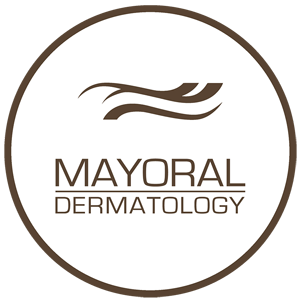Melanoma treatment after diagnosis can be a very simple procedure. Our Dr. Manuel Iriondo of Mayoral Dermatology in Coral Gables specializes in Melanoma diagnosis and treatment.
Today, a diagnosis of melanoma in its early to middle stages can usually be treated successfully using laser therapy, Mohs surgery, chemotherapy, radiation therapy or a combination of one or more of these techniques. Melanoma occurs when damage to skin cell DNA caused by ultraviolet radiation, genetics or other extraneous factors triggers abnormally accelerated cell reproduction. Malignant tumor formations associated with melanoma are almost always in the form of moles, irregularly shaped skin lesions or ulcers. Although melanoma is not the most commonly diagnosed form of skin cancer, it is the most dangerous because it is capable of spreading to other parts of the body.
What is a Biopsy?
Moles or skin lesions suspected of harboring melanoma are routinely evaluated through a procedure called a biopsy. Shave biopsies are frequently used on suspect moles or lesions for the purpose of obtaining a very thin slice of skin containing elements from the epidermis and dermis. Excisional or incisional biopsies are two other commonly performed biopsies indicated by what your doctor has found following close examination of the mole or lesion. An excisional biopsy means the entire area of concern is removed surgically and sent to a laboratory for further evaluation. Alternately, an incisional biopsy involves removing only a small piece of tissue from the mole or lesion for microscopic examination.
A pathologist examines skin biopsies to determine if they are malignant or benign and to “stage” the cancer, if it exists. Staging is based on how deep the melanoma has penetrated into skin layers, its size and if it has metastasized, or spread to other parts of the body, especially the lymph nodes. Stage 0 (melanoma in situ) is the least serious of a melanoma diagnosis and indicates that cancer cells have remained on the top layer of the skin. Stage I, II and III are considered treatable melanomas that differ from each other due to thickness of the tumor and degree of infiltration into the lymph nodes. Stage IV melanoma is rarely diagnosed but represents the worst stage due to metastization of the cancer.
Mohs Surgery
Some patients diagnosed with melanoma will be treated by Mayoral Dermatology’s Dr. Manuel Iriondo, M.D., a licensed physician specializing in Mohs surgery. Skin cancers benefiting from Mohs include basal cell and squamous cell carcinomas in addition to larger melanomas that present irregular borders and are located where preservation of healthy tissue is important—mouth, eyes, nose and hands, for example. Mohs techniques are also used on melanomas that have re-emerged following removal with PDL therapy or a total excision procedure.
By carefully removing one thin layer of skin at a time, examining the layer for evidence of cancer and either continuing to remove layers or ceasing removal means that Mohs surgery offers a high cure rate for skin cancers that does not involve removal of healthy tissue. Moreover, because of the high cure rate associated with Mohs surgery and subsequent reduction in the development of future skin cancers, Mohs is considered one of the most cost-effective treatments in comparison to other melanoma treatments.
Is Mohs Surgery Painful?
Dr. Iriondo will apply a local anesthetic to the lesion before starting the procedure so that the area is fully numbed. Patients are made as comfortable as possible during the treatment and post-operative care instructions involve resting, restricting physical activity and keeping the area as clean as possible. Additional follow-up instructions may be provided if your surgery required suturing.
The Importance of Keeping Appointments
In addition to visiting Mayoral Dermatology for a thorough skin examination every year (or more frequently if you are at risk for developing melanoma), keeping all follow-up appointments is vital to successfully recovering from a diagnosis of melanoma. Making sure that the treated area is healing properly and closely monitoring any skin changes that may indicate the presence of another melanoma is how we maintain our high rate of success in regards to providing effective treatment measures for many types of melanomas.
Neglecting to have a “funny-looking” mole or skin discoloration examined by a professional dermatologist because you are afraid of what may be diagnosed defeats the purpose of quickly and aggressively eliminating skin cancer in its early stages. When melanoma is detected before it reaches Stage II, the cure rate for most people is between 90 and 100 percent. Treatments such as Mohs surgery represents one of the most uncomplicated and often painless methods that can rid your body of cancer and give you a clean bill of health.
Call us today if you suspect you may have melanoma and talk to one of our caring specialists about your fears concerning moles, lesions or other skin anomalies that have been worrying you.

